
The method assumes that the goods issued are those which have been longest on hand and that those remaining in stock represent the latest purchases or production.
The stocks whose cost is to be carried forward were acquired or produced most recently.
NB: materials are issued at the cost price of that consignment which was received first. When this consignment is finished, then cost price of next consignment is finished, then cost price of next consignment is charged to value the materials issued.
This method is based on the assumption that stock purchased first is issued first. Prices of stock purchased first are used to determine the cost or value of inventory issued. Closing stocks are carried at the latest costs.
Advantages
1. It is a realistic system: oldest items are usually issued first out.
2. Unrealized profits or losses do not arise
3. It is easy to calculate if prices of materials don’t fluctuate
4. Closing stocks values reflect the latest costs thus tend to reflect the current market values.
5. It is acceptable to many tax authorities and is also consistent with accounting practices e.g. IAS/IFRS.
Disadvantages
1. It involves tedious calculations if the price of materials fluctuate from time to time
2. Product costs, based on the oldest material prices, lag behind current conditions especially in inflationary markets.
3. Comparison of one job with another may be difficult if materials are issued at different prices.
Wilfykil answered the question on April 17, 2019 at 06:39
-
Name and explain types of Stores
(Solved)
Name and explain types of Stores
Date posted:
April 17, 2019
.
Answers (1)
-
List the features of Effective and Good Store keeping
(Solved)
List the features of Effective and Good Store keeping
Date posted:
April 17, 2019
.
Answers (1)
-
The production manager of Kemu ltd Company, is concerned abut the apparent fluctuation in efficiency and wants to determine how labour costs (in Sh.) are...
(Solved)
The production manager of Kemu ltd Company, is concerned abut the apparent fluctuation in efficiency and wants to determine how labour costs (in Sh.) are related to volume. The following data presents results of the 12 most recent weeks.
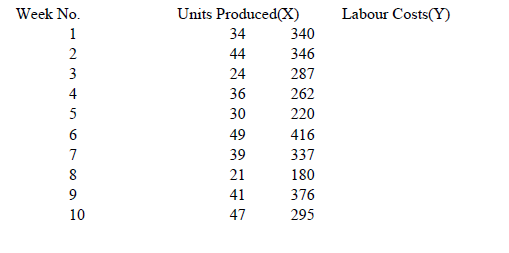

Required:
Estimate the cost function using:
a) The high low method
b) Regression analysis
Assume that the Company intends to produce 45 units, 34 units next period
Estimate the labour cost to be incurred.
c) Assume that the company (in illustration 2.1) intends to spend Sh.400 on labour cost next period. Compute the number of units that the company may produce.
Date posted:
April 17, 2019
.
Answers (1)
-
Based on performance, you have been provided with the following information regarding ABC Ltd for the year ended 31 December 2004 :
(Solved)
Based on performance, you have been provided with the following information regarding ABC Ltd for the year ended 31 December 2004 :

Required:
Develop a total cost function based on the above data using the high-low method.
Date posted:
April 17, 2019
.
Answers (1)
-
What are the advantages and disadvantages of cost estimation?
(Solved)
What are the advantages and disadvantages of cost estimation?
Date posted:
April 17, 2019
.
Answers (1)
-
What is the role of a cost accounting department in an organization?
(Solved)
What is the role of a cost accounting department in an organization?
Date posted:
April 17, 2019
.
Answers (1)
-
The following information for the year ended December 31, 2005 is obtained from the books and records of a factory.
(Solved)
The following information for the year ended December 31, 2005 is obtained from the books and records of a factory.

Factory overhead is 80% of wages and administration overhead 25% of factory cost. The value of the jobs during 2005 was Kshs. 410,000
Prepare:
(i) Consolidated completed jobs account showing the profit made or loss incurred on the jobs.
(ii) Consolidated work – in – progress account.
Date posted:
April 16, 2019
.
Answers (1)
-
As newly appointed cost accounting, you find that the selling price of job No. 5 has been calculated on the following basis:
(Solved)
As newly appointed cost accounting, you find that the selling price of job No. 5 has been calculated on the following basis:
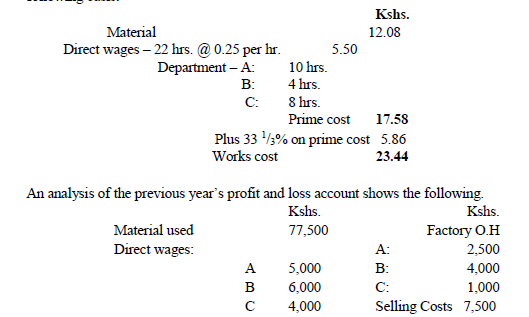
You are required to:
Wage rate: A = Shs. 4 per hour, B = Shs. 6 per hour, C = Shs. 4 per hour.
(a) Draw up a job cost sheet
(b) Calculate and enter the revised costs using the previous year’s figures as a basis (c) Add to the total job cost 10% for profit and give the final selling price.
Date posted:
April 16, 2019
.
Answers (1)
-
The information given below has been taken from the cost records of a factory in respect of job no. 707.
(Solved)
The information given below has been taken from the cost records of a factory in respect of job no. 707.
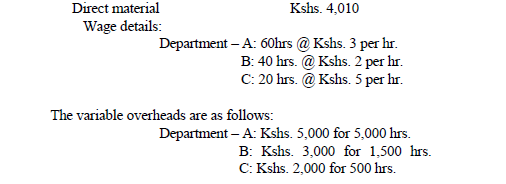
Fixed expenses estimated at Kshs. 20,000 for 10,000 working hours. Calculate the cost of the job No. 707 and the price for the job to give a profit of 25% on the selling price.
Date posted:
April 16, 2019
.
Answers (1)
-
The following figures are extracted from the Trial Balance of AB. Co. on 31st Sep, 2005.
(Solved)
The following figures are extracted from the Trial Balance of AB. Co. on 31st Sep, 2005.
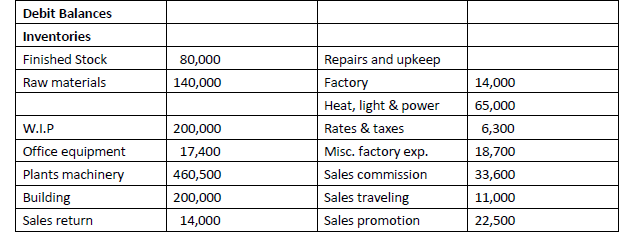
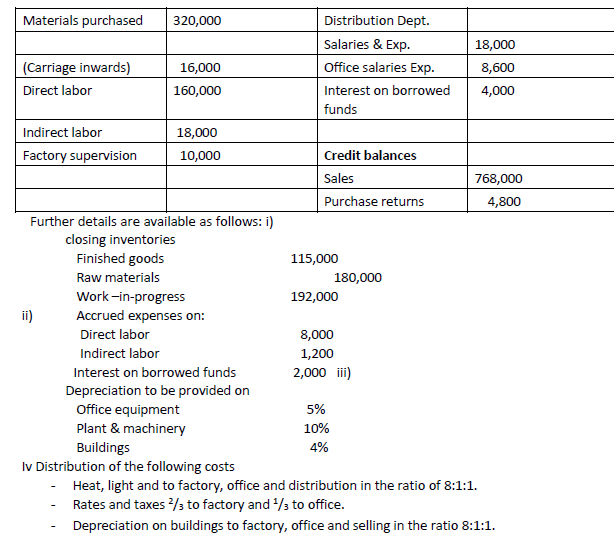
REQUIRED
Prepare
i) A statement of cost showing various elements of cost.
ii) A statement of profit.
Date posted:
April 16, 2019
.
Answers (1)
-
The following extract of costing information relates to commodity ‘A’ for the half year ending 31st Dec. 2005.
(Solved)
The following extract of costing information relates to commodity ‘A’ for the half year ending 31st Dec. 2005.
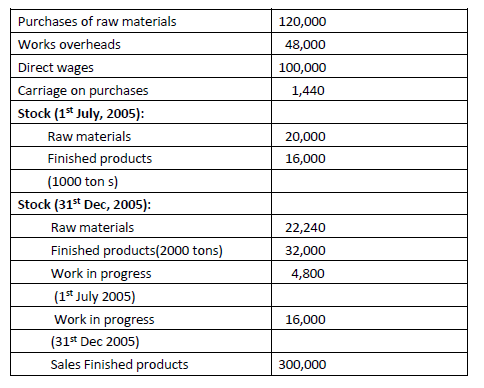
Selling and distribution overheads are Sh. 1 per ton sold. 16000 tons of commodity were produced during the period:
Required:
You are to ascertain
(i) Cost of raw materials used
(ii) Cost of output for the period
(iii) Cost of sales
(iv) net profit for the period
(v) Net profit per ton of the commodity.
Date posted:
April 16, 2019
.
Answers (1)
-
During the month of Dec 2008, 16000 units of standard product were manufactured, out of which 13500 units were sold at 8/- per unit.
(Solved)
During the month of Dec 2008, 16000 units of standard product were manufactured, out of which 13500 units were sold at 8/- per unit. The value of raw material consumed was Sh. 60,000 and the direct wages paid Sh. 16,480. The factory expenses were allocated to production at machine hour’s rate which for this month was Sh. 5 per hour and 1200 machine hours were worked during the month. The office expenses are charged @ 20% on works cost and the selling expenses @ 25cts per unit.
Prepare a cost sheet showing
a) Cost per unit and
b) Profit for the month
Date posted:
April 16, 2019
.
Answers (1)
-
A.B.C Manufacturing Company provides the following information for the month of October 19 – 8
(Solved)
A.B.C Manufacturing Company provides the following information for the month of October 19 – 8
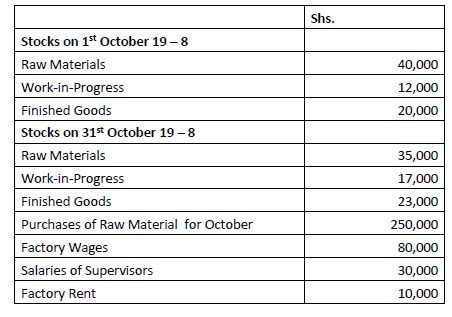
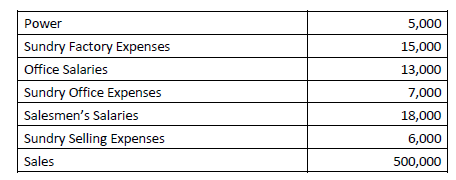
Required:
i. Prepare a production cost statement
ii. Prepare a profit statement
Date posted:
April 16, 2019
.
Answers (1)
-
The following figures are supplied to you by contractor for the year ending 31st December, 1981
(Solved)
The following figures are supplied to you by contractor for the year ending 31st December, 1981
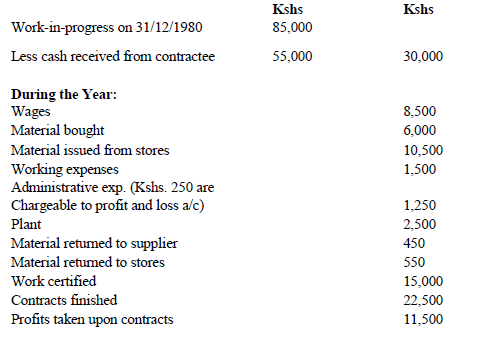
Advances from contractee - 40,000
Prepare contract ledger accounts and the total contractee’s account and show the work-in-progress as it would appear in the Balance Sheet
Date posted:
April 16, 2019
.
Answers (1)
-
A building contractor took a contract to build a building on 1st Jan 1980. The contract price was agreed at Kshs. 800,000. The contractor has...
(Solved)
A building contractor took a contract to build a building on 1st Jan 1980. The contract price was agreed at Kshs. 800,000. The contractor has made the following expenditure during the year:
Materials - 50,000
Direct labor - 30,000
Plant - 80,000
Direct expenses - 20,000
From the following extra information prepare a Contract Account for the year. Also show the amount in work in progress, which will be shown in the balance sheet of the contractor.
Value plant 31/12/1980 - 60,000
Stock of material 31/12/1980 - 10,000
Material returned to store - 2,000
Work certified - 150,000
Cash received - 140,000
Cost of work uncertified - 8,000
Date posted:
April 16, 2019
.
Answers (1)
-
Crystal Construction Limited engaged in contract works has the following Trial Balance on 31st December 1975
(Solved)
Crystal Construction Limited engaged in contract works has the following Trial Balance on 31st December 1975
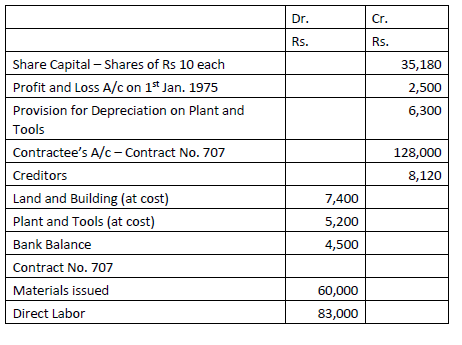

Contract No. 707 having a contract price of Rs. 240,000 was begun on 1st January, 1975 and contractee pays 80% of the work completed and certified. The cost of work done since certification is estimated to be Rs. 1,600. After the above Trial Balance was extracted on 31st December 1975, plant costing Rs. 3,200 was returned to the stores and materials at site on that date were valued at Rs. 3,000. Provision is to be made for sub standard costs amounting to Rs. 600 incurred in contract No. 707 and for depreciation of all Plant and Tools @ 12½% on cost.
Prepare Contract No. 707 Account showing the computation of profit, if any which credit may properly be taken in 1975 and prepare the Balance Sheet for the construction company on 31st December 1975.
Date posted:
April 16, 2019
.
Answers (1)
-
A company of contractors begun to trade on 1st January, 2008.
(Solved)
A company of contractors begun to trade on 1st January, 2008. During 2008 the company was engaged on only one contract of which the contract the contract price was Kshs. 500,000. Of the plant and materials charged to contract: plant costing Kshs. 5,000 and material costing Kshs. 4,000 were lost in an accident. On 31st December, 2008, plant costing Kshs. 5,000 were returned to stores. Cost of work uncertified but finished Kshs. 2,000 and materials costing Kshs. 4,000 were in the hand at site. Charge 10% depreciation on plant and compile contract a/c and balance sheet from the following:-
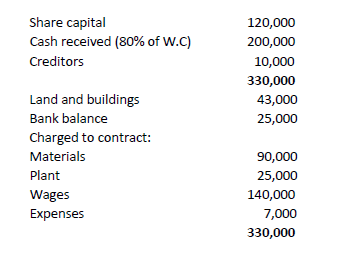
Date posted:
April 16, 2019
.
Answers (1)
-
Construction Ltd. is engaged on two contracts A and B during the year. The following particulars are obtained at the end of the year (Dec....
(Solved)
Construction Ltd. is engaged on two contracts A and B during the year. The following particulars are obtained at the end of the year (Dec. 31)
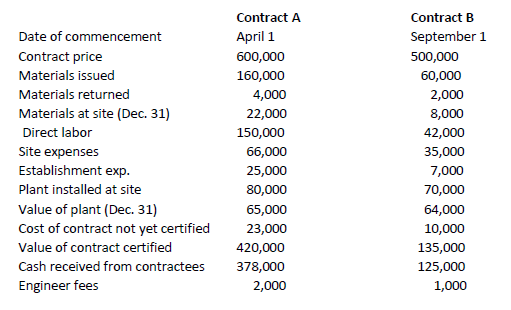
During the period materials amounted to Kshs. 9,000 have been transferred from contract A to contract B.
You are required to show.
(a) Contract account
(b) Contractees accounts
(c) Extract from balance sheet as at Dec. 31.
Date posted:
April 16, 2019
.
Answers (1)
-
The following is the Trial Balance of Premier Construction Company engaged on the execution of Contract No. 747 for the year ended 31st December, 2010
(Solved)
The following is the Trial Balance of Premier Construction Company engaged on the execution of Contract No. 747 for the year ended 31st December, 2010
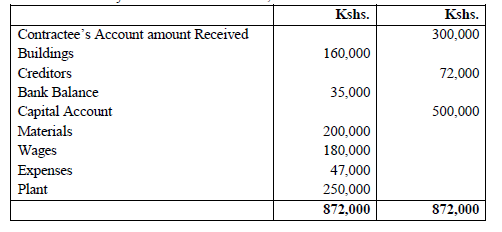
The work on Contract No. 747 was commenced on 1st January 2010. Materials costing Kshs. 170,000 were sent to the site of the contract but those of Kshs. 6,000 were destroyed in an accident. Wages of Kshs. 180,000 were paid during the year. Plant costing Kshs. 50,000 was used on the contract all through the year. Plant with a cost of Kshs. 200,000 was used from 1st January to 30th September and was then returned to the stores. Materials of the cost of Kshs. 4,000 were at site on 31st December, 2010.
The contract was for Kshs. 600,000 and the contractee pays 75% of the work certified. Work certified was 80% of the total contract work at the end of 2010. Uncertified work was estimated at Kshs. 15,000 on 31st December, 2010.
Expenses are charged to the contract at 25% of wages. Plant is to be depreciated at 10% for the entire year. Prepare Contract no. 747 Account for the year 2010 and make out the Balance Sheet as on 31st December 2010 in the books of premier Construction Co.
Date posted:
April 16, 2019
.
Answers (1)
-
From the following information, prepare contract account. Show how these figures appear in the extracts balance sheet as at 31st December, 2005.
(Solved)
From the following information, prepare contract account. Show how these figures appear in the extracts balance sheet as at 31st December, 2005.
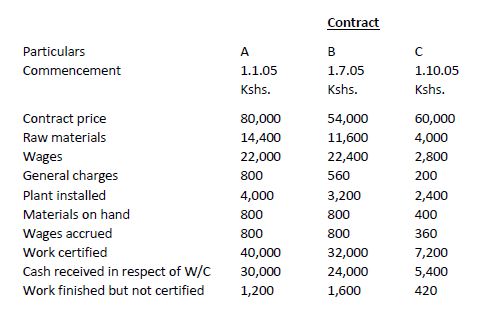
Depreciation is to be charged on plant@ 10% which was installed on the opening date of the contract in each case.
Date posted:
April 16, 2019
.
Answers (1)